Victory Motorcycles is returning with the Victory Racing team to compete in the Isle of Man TT Zero race with an all-new electric race bike called the Victory RR. The Victory RR electric motorcycle has been developed over the past year using data gathered during last year’s TT Zero and will be ridden by William Dunlop.
This means Victory Racing is fielding entries in two of the world’s most gruelling road races – Pikes Peak in the USA and the Isle of Man TT in Europe. Commenting on the return to the Isle of Man TT, Alex Hultgren, Director of Marketing for Victory Motorcycles said:
“One way we continuously push ourselves in performance is through our Victory Racing initiatives. The Isle of Man TT is one of the most challenging motorcycle races in the world, so of course we have to be there.”
Victory’s international R&D development program is well underway and the Victory RR bike, as well as the ones racing at Pikes Peak, are test beds for technology that will be used in the firm’s future products. Victory Racing’s team manager, Brian Wismann said:
“Our electric Empulse RR race bike placed third on the podium in the TT Zero race last year, which we were thrilled with. Using the data we gathered on our laps of the TT course has helped us to develop a new battery module as well as improving the powertrain. We feel like we can return to the TT with more performance as well as being able to test this technology for our future products.”
Alex Hultgren adds:
“This year with a new machine and new technology behind us we continue to have high expectations. We are working to develop the best platform for our racer, William Dunlop, who is familiar with the view from the podium.”
Brian Wismann gives a further insight in to what is new on the RR.
“The newly developed battery leverages the lessons learned from our entry in last year’s TT Zero event. The battery is a ground-up new design with the help of our technical partners at Brammo and necessitated a big change in the chassis design – from an extruded aluminum twin spar to a steel trellis frame. The biggest difference in the battery itself is an improvement in both the overall energy / capacity we’re carrying on board the bike, as well as a marked improvement in the energy density of the battery itself. As you know, lithium-ion battery technology is improving every year and with the Victory RR we are leading the way to batteries that will provide more performance, greater range and less cost in future vehicles.”
Some enhancements have also been made to the electric motor. Developed in partnership with Parker Hannifin, the motor is called the Parker GVM. It boasts world-class specific power (the power to weight ratio), producing a peak of over 170hp from a package that is only eight inches in diameter and five inches long. With peak efficiencies topping 97%, it is clear to see why Victory is excited about the potential of this powertrain for future products.
Brian Wismann adds:
“Compared to the electric motor we used in the TT Zero event last year, this year’s version features an even further optimised winding configuration based on the data gathered from last year’s bikes. Coupled with the increased energy on board in the battery, William Dunlop will have access to more of the power available from this motor than in 2015.”
The first practice for the SES TT Zero is scheduled for Friday 3rd June at 20:40 with second practice on Saturday 4th June at 17.15 and a final qualifying session on Monday 6th June at 16:25. The race is scheduled at 16:25 on Wednesday 8th June.
Victory RR Technical Specification
| Length/Width/Height (mm) | 2089 / 680 / 1218 |
|---|---|
| Seat Height (in.) | 32 |
| Weight (kg) | 240 |
| Front Tire | Metzeler 120/70 R17 |
| Rear Tire | Metzeler 200/60 R17 |
| Frame | Trellis Steel and Composite Monocoque |
| Motor | Parker GVM Water-cooled, 3-phase, IPM AC |
| Max Power (kW/HP) | 130 / 174 |
| Max Torque (Nm) | 240 |
| Battery | Brammo Power Lithium-Ion |
| Battery Voltage (Vdc) | 370 or more |
Source; Victory Motorcycles
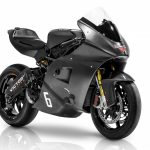
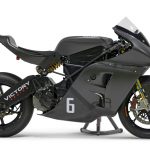
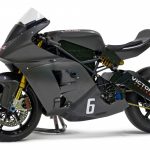
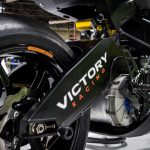
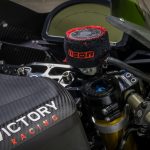

My stock 400ccm scooter can put well over 300Nm on the wheel. So 240Nm isn’t very impresive.
Wheel Torque and Engine Torque are not the same thing…..
That’s the point. Engine torque is useless without giving the gear ratio since only wheel torque is making the push.
So what is your engine torque? A typical 400cc Scooter would probably put out around 30Nm with around 30HP.
Ralf, what scooter do you have? I’d expect an average 400cc scooter to have more like 30Nm rather than 300 Nm torque. e.g. https://www.yamaha-motor.eu/uk/products/scooters/sport/xmax400.aspx?view=featurestechspecs
It’a Brugman 400 from Suzuki. It has up to 33Nm at the crank shaft.
The variator has a gearing ratio of 0.8 to 2.2 and a final drive ratio of 5.8 which theoreticly multiplies to up to 420Nm.
Since you can’t get maximum gearing and maximum torque at the same time i estimated (and calculated by acceleration) around 300Nm.
The figures to compare then are the Victory’s 240Nm torque to your scooter’s 33Nm – electric motor vs. engine, not taking into account gearing or final drive.
The torque pushing you forward is wheel torque. That’s why it’s useless to give engine torque without gear ratio.
Based on the pictures I estimate the gear ratio of the Victory between three and four. So wheel torque surely is over 800Nm. Traction limit typicaly is about 900Nm.